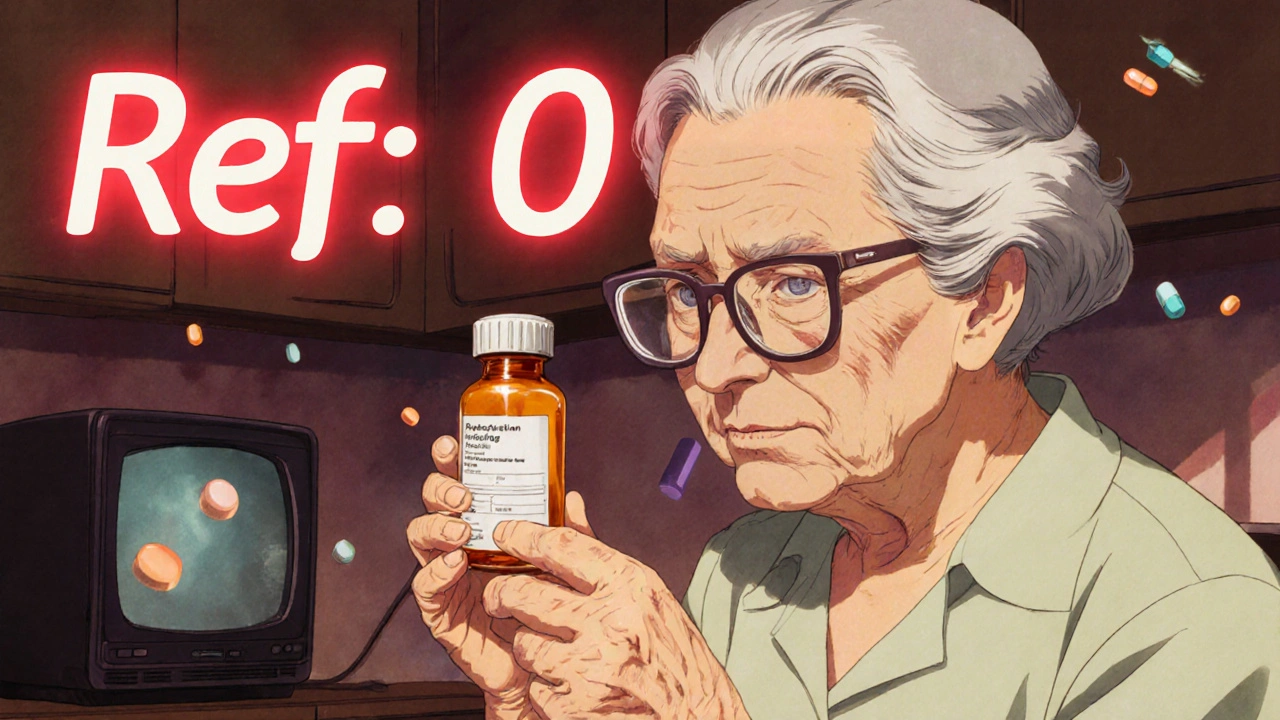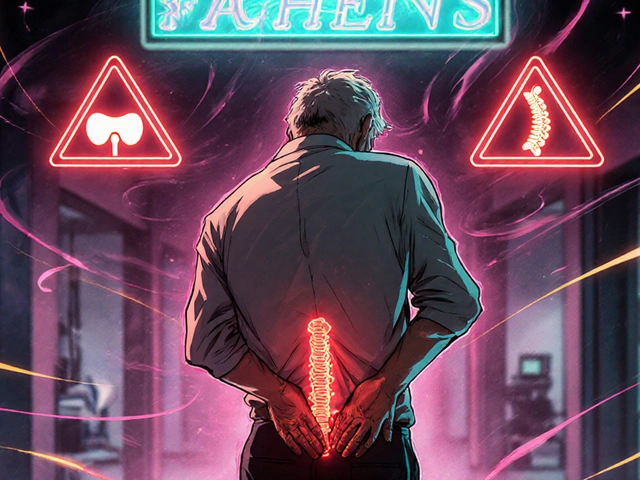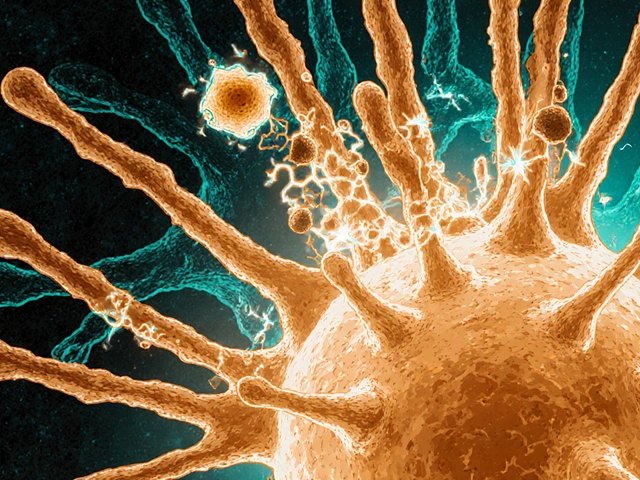Ever looked at your prescription label and wondered what that little "Ref: 3" or "Refills: 0" really means? It’s not just clutter-it’s your lifeline to keeping your meds on track. If you’ve ever run out of medicine because you didn’t realize your refills were gone, you’re not alone. A 2022 survey found that 15-20% of calls to doctors’ offices are from patients who thought "Ref: 0" meant they had zero pills left, not zero refills. That’s a simple misunderstanding with serious consequences.
Where to Find Refill Information on Your Label
Refill info doesn’t hide. It’s usually at the bottom or middle of your prescription label, away from the dosing instructions so you don’t miss them. Look for words like "Ref:", "Refills:", or "Remaining Refills:" followed by a number. Some labels say "Refills: 0"-that means you can’t get more without a new prescription. Others might show "Ref: 5"-meaning you’ve got five more chances to fill it.
Pharmacies like CVS, Walgreens, and independent shops all follow similar standards, but layout varies. CVS uses color-coded sections and places refill info near the prescription number and fill date. Independent pharmacies often follow guidelines from groups like the Pharmacy Association of Nova Scotia, which recommend putting refill numbers in larger font than the total authorized refills so you can’t miss them.
Don’t rely on memory. Check the label every time you pick up a new bottle. The number changes after each refill. If it says "Ref: 3" today, next time it’ll say "Ref: 2"-and so on.
What "Ref: 0" Really Means
This is where most people get tripped up. "Ref: 0" does NOT mean you’re out of pills. It means you’ve used up all the refills your doctor allowed. You still might have pills left in the bottle-but you can’t get more without going back to your provider.
Some medications, like insulin, blood pressure pills, or antidepressants, are meant to be taken long-term. But even those have refill limits. Why? Because your doctor needs to check how you’re doing, adjust your dose if needed, or make sure there aren’t dangerous interactions with other meds.
If you see "Ref: 0" and still need medicine, call your pharmacy. They’ll let you know if they can request a refill from your doctor-or if you need to schedule an appointment. Don’t wait until you’re out. Some controlled substances, like painkillers or ADHD meds, take up to 72 hours to process a refill request.
Why Refill Limits Exist
It’s not about bureaucracy. Refill limits protect you.
For certain drugs-especially opioids, benzodiazepines, or stimulants-federal and state laws require refill limits to prevent misuse. Even for everyday meds like statins or metformin, your doctor sets limits so they can monitor your health. Maybe your blood sugar improved and you need a lower dose. Maybe your kidneys aren’t handling the drug like they used to. Without regular check-ins, those changes go unnoticed.
Also, insurance companies often tie refill timing to coverage. Medicare Part D, for example, usually lets you refill a 30-day supply after 23 days. Commercial insurers like UnitedHealthcare let you refill after 80% of the supply is used-so for a 30-day pill, that’s day 24. If you try to refill too early, your claim will be denied.
How to Avoid Running Out
Don’t wait until your bottle is empty. Set a reminder on your phone: 3-5 days before you think you’ll run out, check your refill count. If it’s 1 or 0, call your pharmacy. Most can process requests within 24 hours for non-controlled meds.
Some pharmacies offer automatic refill programs. CVS’s "worry-free refills" and Express Scripts’ text alerts notify you when your med is ready. These services work best if you’ve signed up and kept your contact info updated. If you miss a notification, you might still get a refill-but you could also end up with a gap.
Keep a list of your meds and their refill counts in your phone or wallet. Write down the name, dose, and refill number for each. That way, if you’re at the pharmacy and can’t find your label, you’ve got backup info.
Digital Tools Making Refills Easier
Technology is helping. CVS’s "Spoken Rx" feature lets you scan your pill bottle with your phone and hear the name of your medicine and your refill status read aloud-in English or Spanish. It’s especially helpful for older adults or people with vision issues.
By 2025, 85% of U.S. pharmacies are expected to use digital reminders via text or app alerts. Right now, about half do. If your pharmacy offers this, sign up. It’s free and cuts down on missed refills.
There’s also a new universal refill icon being tested by the American Pharmacists Association. In pilot studies, using a simple symbol-like a circular arrow with a number inside-reduced refill-related errors by 41%. If it rolls out nationwide, you’ll see it on labels soon.

What to Do If You’re Out of Refills
Step 1: Check your bottle. Do you still have pills? If yes, you just need a refill authorization.
Step 2: Call your pharmacy. They can often request a refill from your doctor right away. Many have direct electronic links to prescribers.
Step 3: If your doctor is closed, ask the pharmacy if they can give you an emergency supply. For chronic conditions like diabetes or heart disease, pharmacists in many states can provide a 3-7 day emergency refill without a new prescription.
Step 4: Schedule a doctor’s visit if you’re out of refills often. Maybe your treatment plan needs updating. Maybe your insurance changed. Either way, it’s a chance to talk through your needs.
Why This Matters for Your Health
Running out of meds isn’t just inconvenient-it’s dangerous. A 2022 study tracking over 12,000 patients found that those who understood their refill info were 37% less likely to have a medication interruption. That’s huge. Missing doses for blood pressure or diabetes meds can lead to hospital visits.
Clear refill info also reduces unnecessary doctor visits. When patients know what "Ref: 0" means, they stop calling just to ask if they can get more pills. Pharmacists report that 1 in 5 refill calls are from people who just didn’t read the label.
And it’s not just about pills. Understanding your label means you’re in control of your health. You’re not guessing. You’re not waiting. You’re acting.
Quick Checklist: What to Do Every Time You Get a Prescription
- Find the refill number: Look for "Ref:" or "Refills:"
- Write down the number and the date you picked it up
- Set a phone reminder for 3-5 days before you think you’ll run out
- If refill count is 0, call your pharmacy-not your doctor-first
- Ask if your pharmacy offers automatic refill alerts or app notifications
Your prescription label isn’t just a receipt. It’s your instruction manual for staying healthy. Take five seconds every time you pick up your meds to read the refill info. It could save you a trip to the ER, a missed workday, or worse.
What does "Ref: 0" mean on my prescription label?
"Ref: 0" means you’ve used up all the refills your doctor authorized. It does NOT mean you’re out of pills. You still might have medicine left in the bottle, but you can’t get more without a new prescription. Call your pharmacy to request a refill from your doctor.
Why can’t I refill my prescription even though I still have pills left?
Doctors set refill limits to make sure your condition is being monitored. For some medications, like blood pressure or diabetes drugs, your dose may need to change based on how you’re doing. Insurance rules also play a role-many plans only allow refills after a certain number of days have passed since your last fill. Even if you have pills, you still need to follow the refill rules.
How many refills are typically allowed on a prescription?
It depends on the medication and your doctor’s instructions. For chronic conditions like high cholesterol or thyroid issues, you might get 3-6 refills. For controlled substances like painkillers or ADHD meds, federal law limits you to 5 refills within 6 months, and often you’ll only get 1-2. Always check your label-your doctor decides the number.
Can I get an emergency refill if I run out on a weekend?
In many states, pharmacists can give you a short-term emergency supply-usually 3 to 7 days-for chronic conditions like diabetes, heart disease, or asthma. This is not guaranteed, but it’s allowed under state laws designed to prevent harm. Call your pharmacy first. They’ll know what’s possible in your area.
Why do some pharmacies have different refill label formats?
While most pharmacies follow national guidelines from the U.S. Pharmacopeial Convention, individual states have their own rules. California, for example, requires explicit "No Refills" wording, while Texas requires both total and remaining refills to be shown. Chain pharmacies like CVS and Walgreens also design their own layouts for branding or app integration. But the core info-how many refills you have left-is always there.
What should I do if my refill info is too small to read?
Ask your pharmacy for a larger-print label. Most will print a second copy with bigger text at no extra cost. You can also ask if they offer digital access through their app-many let you view your prescription details, including refill count, online. CVS’s Spoken Rx feature even reads the label aloud if you scan it with your phone.
Do insurance plans affect how often I can refill?
Yes. Medicare Part D usually lets you refill a 30-day supply after 23 days. Commercial insurers like UnitedHealthcare allow refills at 80% of the supply period-so for a 30-day prescription, you can refill after 24 days. If you try to refill too early, your claim will be denied. Always check your plan’s rules or call your insurer if you’re unsure.







Melvina Zelee
24 November, 2025 21:38 PMive literally run out of my anxiety meds because i thought "ref: 0" meant no pills left. i cried in the pharmacy parking lot. turns out i had 14 left. dumb, right? but now i screenshot the label every time. no more guessing.
Latonya Elarms-Radford
26 November, 2025 04:18 AMah yes, the tragicomic ballet of modern pharmaceutical bureaucracy-where a single digit on a sticky label becomes the fulcrum upon which the entire architecture of personal health hangs in the balance. we are not merely patients, we are unwitting participants in a grand, unspoken ritual of bureaucratic absurdity, where the state, the insurer, and the pharmacist conspire in silent collusion to remind us that our autonomy is conditional, our bodies are data points, and our dignity is indexed by refill counts. ref: 0 is not a number-it’s a metaphor for systemic neglect wrapped in Helvetica font.
Mark Williams
27 November, 2025 14:50 PMthe refill paradigm is a pharmacoeconomic control mechanism designed to enforce therapeutic adherence while mitigating polypharmacy risk. the 80% refill threshold for commercial insurers aligns with pharmacokinetic half-life modeling and reduces stockouts by 22% per CDC 2021 data. if you’re hitting ref: 0, you’re not out of pills-you’re at the compliance inflection point. automate alerts, sync with your EHR, and stop treating meds like grocery items.
Ravi Kumar Gupta
28 November, 2025 21:25 PMin india, we just call the pharmacy and say "bhaiya, refill chahiye"-they call the doctor, and boom, done. no apps, no scans, no 72-hour waits. but here? you need a degree in insurance law just to get your blood pressure pills. why is it so hard in the richest country on earth?
manish chaturvedi
29 November, 2025 22:45 PMin many Asian cultures, medication adherence is viewed as a familial responsibility. elders often keep refill calendars and remind younger members. perhaps we should adopt that model here-instead of leaving patients to decode cryptic labels alone, we could build community support systems. it’s not just about information-it’s about connection.
Nikhil Chaurasia
30 November, 2025 14:01 PMi once waited three days to get a refill because i was too afraid to call. i didn’t want to bother anyone. i ended up in the ER with a panic attack. the pharmacist said, "you don’t have to be polite to survive." i’ve never forgotten that.
Holly Schumacher
1 December, 2025 17:24 PMthe fact that this article even needs to exist is a national embarrassment. if you can’t read "Ref: 3" without a PhD in pharmacy labeling semantics, then maybe you shouldn’t be managing your own medications. this isn’t a literacy crisis-it’s a negligence crisis. and no, "Spoken Rx" is not a solution, it’s a Band-Aid on a hemorrhage.
Shawn Daughhetee
3 December, 2025 01:31 AMmy grandma taught me to always check the bottom of the bottle. she said "if you don’t read it, it don’t care if you live or die". i still do it. no apps needed. just eyes and a little patience.
Miruna Alexandru
4 December, 2025 02:40 AMwhile the article presents a surface-level solution to a systemic issue, it fails to interrogate the underlying power dynamics of pharmaceutical gatekeeping. the refill limit is not a clinical tool-it’s a mechanism of control designed to maximize provider revenue and minimize liability. the fact that patients are expected to self-educate on regulatory minutiae is a form of epistemic violence disguised as patient empowerment.
Justin Daniel
4 December, 2025 04:26 AMlol i used to think "ref: 0" meant "you’re out of luck". then i learned it meant "call the pharmacy, they’ll fix it". now i just smile at the pharmacist and say "hey, can you work your magic?" and they do. turns out, humans are still better than apps.
ann smith
4 December, 2025 19:23 PMyou got this 💪 i know it feels overwhelming but checking your label once a week is a tiny act of self-love. you deserve to feel safe and in control. if you need help setting reminders, i’m happy to walk you through it 😊